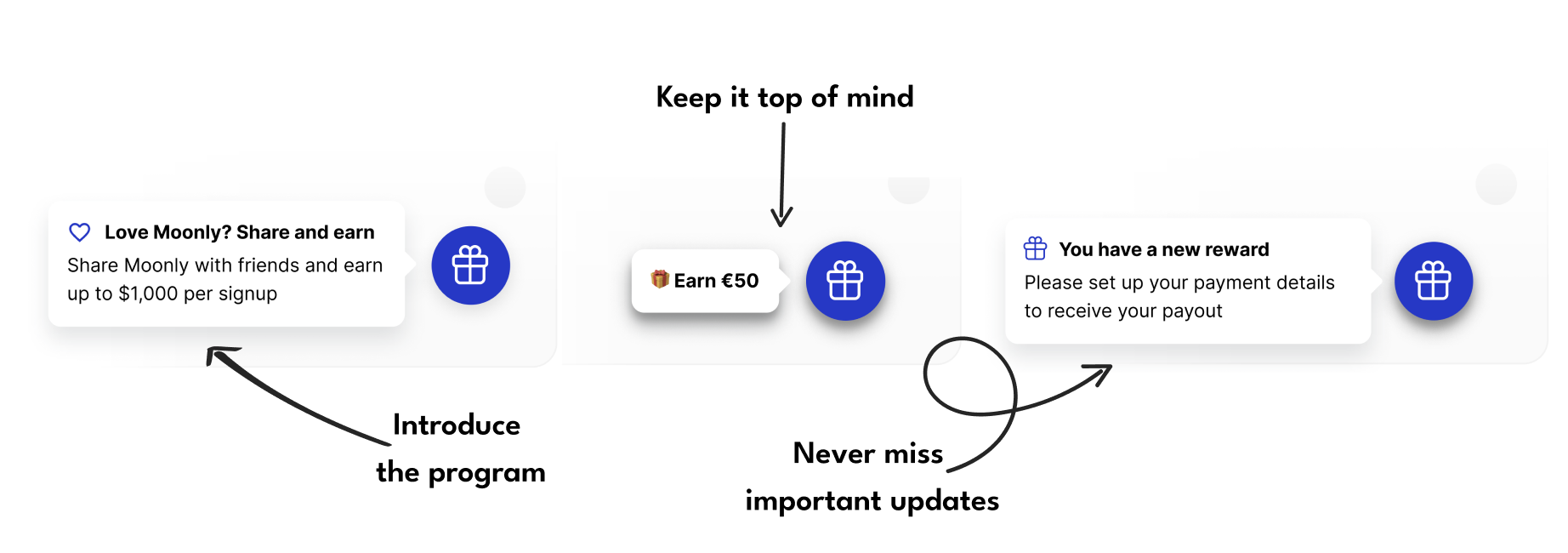If you’re evaluating Cello vs PartnerStack for referral programs, this guide summarizes integration effort, attribution reliability, in‑app experience, notifications, campaigns, and payouts to inform your choice.
Cello embeds a native referral panel with server‑side attribution and in‑app + email journeys. PartnerStack focuses on a broad partner portal and JS SDK; users typically manage links and payouts on an external dashboard.
Overview
- In‑product referral UI: Cello’s Referral Component lives inside your app; users can copy links, view stats, and manage rewards without leaving.
- Portal‑centric model: PartnerStack centers on an external portal and SDK; in‑app referral UI is minimal and often redirects to PartnerStack.
Integration and UX embedding
| Topic | Cello | PartnerStack |
|---|
| Referral UI embedding | Embedded referral panel in‑app; shows each user’s link, stats, rewards, fully native to your UX. | JS SDK and simple iFrame form for collecting emails/generating links. No in‑app referral dashboard; users manage referrals on PartnerStack’s site. |
| Custom launcher / placement | Flexible launcher: attach panel open to any element (menu item, button). Replace or hide the default floating button for a fully branded UX. | No native launcher concept; teams create custom buttons/links to open forms or redirect to the portal. |
Example
Open Cello’s panel from an “Invite Friends” button in your app; PartnerStack typically takes users out to an external dashboard for management.

Notifications and engagement
Cello includes an in‑app and email notification system for referral programs:
- In‑app alerts & badges for referral joins or rewards earned.
- Announcements prompting next steps (e.g., add payout details).
- Email lifecycle for welcome, reward earned, and unclaimed reminders.
- Behavior‑based timing to coordinate prompts and reminders.
 PartnerStack does not provide native in‑app notifications. It relies on webhooks and external email triggers; custom in‑app messaging requires manual builds, requiring additional development effort.
PartnerStack does not provide native in‑app notifications. It relies on webhooks and external email triggers; custom in‑app messaging requires manual builds, requiring additional development effort.
Mobile SDKs
| Topic | Cello | PartnerStack |
|---|
| Native mobile SDKs | iOS, Android, React Native SDKs with a plug‑and‑play referral component. | No native mobile SDK; focuses on partner portal, JS tracking, and referral iFrame. |
| Integration pattern | Quick install (SPM/CocoaPods/Gradle). Initialize with product ID/user token; supports native share sheets and custom launchers. | Mobile apps embed a portal/iFrame or build custom UI against REST APIs; referrals managed in external portal. |
| In‑app referral UI | Embedded mobile panel that is themable and aligns with app UI. | No pre‑built in‑app referral panel; experiences are portal/web‑based. |
| Payout support | Platform includes automated payouts and KYC compliance (outside SDK code). | Payouts managed via PartnerStack portal on monthly cycles; not inside your app. |
If you need native iOS/Android referral experiences, Cello’s SDKs provide the in‑app component. PartnerStack is portal‑centric and requires custom app work or redirects.
Attribution: client vs server flow
| Topic | Cello | PartnerStack |
|---|
| Client dependency | Backend‑centric tracking: attribution on server events (e.g., Stripe webhooks); no cookies or client scripts required. | Client‑centric tracking via JS snippet and cookies; requires a front‑end call to confirm conversions. Missing scripts or blockers can break attribution. |
| Stripe / metadata | Server metadata‑based: referral codes stored on Stripe objects; attribution via webhooks. | Cookie & ID matching: matches by email or client IDs, often with delays. Server‑side setup is optional and more complex. |
Server‑first attribution remains reliable across strict privacy environments, mobile apps, and blocked scripts. PartnerStack’s JS flow is browser‑dependent unless hardened with server integrations.
Campaigns, rewards, and payouts
Campaign design and reward rules
| Aspect | Cello | PartnerStack |
|---|
| Campaign flexibility | Multiple reward types in one campaign: % commissions, bonuses, caps, and friend discounts. | Managed via Triggers: one reward per trigger; complex logic requires multiple triggers. |
| Reward types | Combine % and fixed bonuses, plus new‑user discounts, in a single setup. | Each trigger offers a single flat or % reward; no native friend‑gets‑X incentives in the same flow. |
Payout management
| Aspect | Cello | PartnerStack |
|---|
| Fulfillment | Automated payout calculation and initiation. | Monthly batch payouts via the portal or manual approval. |
| User Experience | Referrers choose payout method (e.g., PayPal, Venmo) inside your app. | Users get paid via PartnerStack’s portal, not inside your product. |
| Workflow | Real‑time payout updates and in‑app notifications. | External batch payout cycle, disconnected from your UX. |
Recurring rewards and multi‑month commissions
| Aspect | Cello | PartnerStack |
|---|
| Recurring commissions | Native recurring and time‑bound rewards (e.g., 6‑month caps). | Recurring commissions supported; time limits require manual setup. |
| Control | Built‑in duration and reward caps. | Requires manual review or multi‑trigger management. |
Summary: key differences
- In‑app UI vs portal: Cello is embedded; PartnerStack is portal‑centric.
- Engagement: Cello provides in‑app + email journeys; PartnerStack relies on external comms.
- Attribution: Cello is server‑first via metadata/webhooks; PartnerStack defaults to client/cookie tracking.
- Campaigns: Cello composes multiple rewards in one campaign; PartnerStack uses single‑reward triggers.
- Payouts: Cello supports in‑app payout flows; PartnerStack manages payouts externally.
- Mobile SDKs: Cello offers native iOS/Android/React Native SDKs with an embedded component; PartnerStack has no native mobile SDK (portal‑centric).
Choose the platform that matches your desired integration model, attribution requirements, and operational ownership. 
 PartnerStack does not provide native in‑app notifications. It relies on webhooks and external email triggers; custom in‑app messaging requires manual builds, requiring additional development effort.
PartnerStack does not provide native in‑app notifications. It relies on webhooks and external email triggers; custom in‑app messaging requires manual builds, requiring additional development effort.